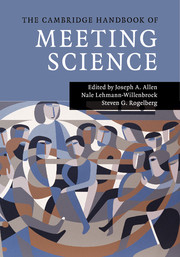Book contents
- The Cambridge Handbook of Meeting Science
- The Cambridge Handbook of Meeting Science
- Copyright page
- Dedication
- Contents
- Tables
- Figures
- Contributors
- Book part
- Part I Introduction
- Part II Premeeting Activities and Context
- Part III The Meeting Itself
- Part IV Special Types of Meetings
- Part V Synthesis and Conclusion
- Book part
- Author Index
- Subject Index
- References
Part V - Synthesis and Conclusion
Published online by Cambridge University Press: 05 August 2015
- The Cambridge Handbook of Meeting Science
- The Cambridge Handbook of Meeting Science
- Copyright page
- Dedication
- Contents
- Tables
- Figures
- Contributors
- Book part
- Part I Introduction
- Part II Premeeting Activities and Context
- Part III The Meeting Itself
- Part IV Special Types of Meetings
- Part V Synthesis and Conclusion
- Book part
- Author Index
- Subject Index
- References
Summary
As much as the field of industrial-organizational psychology and allied fields associated more generally with organizational science strive to be scientist and practitioner oriented, much organizational research conducted by scientists is not readily accessible to practitioners in the field. Scientists in recent years have built an impressive research base on the topic of workplace meetings. There is also a voluminous nonscientific, or at least not explicitly scientific, practice literature on effective meetings. This chapter provides an overview of some of the primary evidence-based conclusions from the behavioral-science research on meetings and of central dominant themes from the practice literature. Then, acknowledging the similarities (and differences) between the two spheres of meeting knowledge, the chapter outlines core prescriptions for effective meetings drawn from both domains as well as from my applied experience. In concluding, I offer some thoughts about making our science more relevant.
- Type
- Chapter
- Information
- The Cambridge Handbook of Meeting Science , pp. 707 - 746Publisher: Cambridge University PressPrint publication year: 2015

